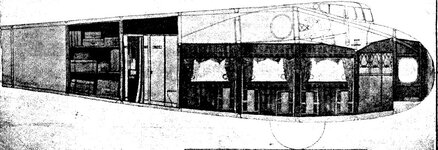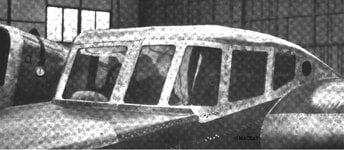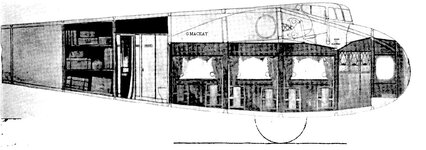Navigation
Install the app
How to install the app on iOS
Follow along with the video below to see how to install our site as a web app on your home screen.
Note: This feature may not be available in some browsers.
More options
You are using an out of date browser. It may not display this or other websites correctly.
You should upgrade or use an alternative browser.
You should upgrade or use an alternative browser.
ZEPPELIN-STAAKEN R-XVII
- Thread starter delcyros
- Start date
Ad: This forum contains affiliate links to products on Amazon and eBay. More information in Terms and rules
More options
Who Replied?Soundbreaker Welch?
Tech Sergeant
hi?
The main problem was the engines which exceeded treaty limitations. They were told to remove them and they did. With no engines the aeroplanes were broken up and that included the twin-engined version. The Allied Control Commission inspected two Staaken aeroplanes. The last one had an enclosed cockpit. The commission also had the belief the aircraft would have been used as a bomber with a load of 500kg. The aeronautical press were livid at the loss of such a modern airframeThank You, Graeme.
I have traced down the original image for Gunstons drawing:
(source: Booklet from Zeppelin exhibition Friedrichshafen 2006, Deutsches Museum, Ulf Essers, Peter M. Grosz)
The Inter-Allied Controll Commission allowed construction and test flights of this plane. But once they realised after test flights that only two fighter-types could reasonably match the speed of this giant they
demanded the plane to be scrapped. Junkers was clever enough not to quest for extreme performances.
Another novel figure was the washing room in the stern and the bord toilet.
vikingBerserker
Lieutenant General
Very cool!
Nice shots!
The Entente Inspection team records Two Staaaken airliners. The one with the cockpit must be the second one. What a waste destroying them.
There was only one E 4/20 built, so it's possible that the inspection team referred to one of the existing airframes from the concern at the site. It might have been the incomplete remains of the third R XVI, two of which were built and flown as bombers during the war, but a third, partially completed was investigated for conversion into a civil transport. Staaken was the name given to the Zeppelin company's operation at the Berlin airfield of Staaken, where it had an airship shed and extensive facilities for the construction of the big Riesenfluzeuge during the war. Unfortunately, the staff destroyed a lot of paperwork at the end of the war, so records on exactly what went on at Staaken are incomplete, outside of what was actually built.
These photos were taken at Staaken in 2019, this is the rear of the Zeppelin main offices built during the Great War, now derelict on a featureless industrial site.
This is the Staaken control tower that was originally attached to a big hangar, within which those big R aircraft were built and stored, now long gone. Oddly, Staaken has its own MacDonalds, where my friend and I, snooping around derelict sites of interest around Berlin had lunch!
The problem is that cockpit canopy, when was it fitted? There are photographs with the destroyed Staaken with that cockpit. and the inspectors mentioning two Staakens. They also mention the twin engined Staaken, there are images of the aeroplanes in contemporary magazines. Since I've seen the reports by the inspectors I'll have to go with what they say. Seemingly the twin engine Staaken received enquiries from America where they wanted to put it into production, but the design was butchered by the Entente inspectors.
I don't think I denied there was another Staaken airliner, but there was only the one E 4/20 built, so whatever the other aircraft was it was a twin-engined airliner, which the E 4/20 was not. Photos showing the E 4/20 under construction display its four engine cradles mounted on the wings, so whatever the inspection team saw it wasn't a second E 4/20 if it were twin-engined. Regarding the cockpit canopy on the E 4/20, it certainly wasn't completed with it as contemporary images in 1920 show it without one, but when it was fitted, who can say precisely as it was scrapped two years after it was finished. Like I said, documentation and pertinent information was destroyed after the war...The problem is that cockpit canopy, when was it fitted? There are photographs with the destroyed Staaken with that cockpit. and the inspectors mentioning two Staakens. They also mention the twin engined Staaken, there are images of the aeroplanes in contemporary magazines.
I have pictures of the second one's cockpit being fitted and the twin engined one being built,. Contemporary press reports give full coverage to the types and certainly the inspector's reports have supporting drawings. The fuselage windows are completely different in the second Staaken. There are photos of it engineless and then shown broken up. Certainly the inspectors say there were two four engined types and one tin engined typeI don't think I denied there was another Staaken airliner, but there was only the one E 4/20 built, so whatever the other aircraft was it was a twin-engined airliner, which the E 4/20 was not. Photos showing the E 4/20 under construction display its four engine cradles mounted on the wings, so whatever the inspection team saw it wasn't a second E 4/20 if it were twin-engined. Regarding the cockpit canopy on the E 4/20, it certainly wasn't completed with it as contemporary images in 1920 show it without one, but when it was fitted, who can say precisely as it was scrapped two years after it was finished. Like I said, documentation and pertinent information was destroyed after the war...
I have pictures of the second one's cockpit being fitted and the twin engined one being built,. Contemporary press reports give full coverage to the types and certainly the inspector's reports have supporting drawings. The fuselage windows are completely different in the second Staaken. There are photos of it engineless and then shown broken up. Certainly the inspectors say there were two four engined types and one tin engined type
so, what you are saying is that there were two E 4/20? If that is the case, then that is quite a significant historic find. Firstly, however, you need to prove that what you are saying is true and verifiable. If you cannot, then it is simply presumption on your part. Let's see the evidence.
Its all coming out in a book called, German aircraft in the Great War." Hopefully February 14, publishing date, all the facts are in thatso, what you are saying is that there were two E 4/20? If that is the case, then that is quite a significant historic find. Firstly, however, you need to prove that what you are saying is true and verifiable. If you cannot, then it is simply presumption on your part. Let's see the evidence.
Attachments
Here's the cockpit, seemsthe aircraft was designed in March 1919 and flew in September 1920. The Allies gave them the engines for the test flights then took them back. So we can say the cockpit was fitted after September 1920 because the airframe was destroyed in January 1921. Rohrbach stated that the cockpit was fitted around that time. So we can safely say there was one Staaken but the inspectors reported two and the twin engined one.Its all coming out in a book called, German aircraft in the Great War." Hopefully February 14, publishing date, all the facts are in that
Attachments
So we can safely say there was one Staaken but the inspectors reported two and the twin engined one.
Again, intriguing, but aside from saying a book will be published, how about a scan of a document or other verifiable source, because obviously if there was more than one then that alters known history. Verification is required though, otherwise it's just your word against everyone else's.
Publisher will not allow that on a web site-its oen to plundering.Its in the book and a bit of research will be fruitful- of course the inspectors could have made a mistakeAgain, intriguing, but aside from saying a book will be published, how about a scan of a document or other verifiable source, because obviously if there was more than one then that alters known history. Verification is required though, otherwise it's just your word against everyone else's.
Publisher will not allow that on a web site-its oen to plundering.Its in the book and a bit of research will be fruitful- of course the inspectors could have made a mistake
Obviously. A source wouldn't be amiss though. Justification for an unproven claim should be better served than just saying "wait for the book". I've seen and heard this so many times that I have seen authors and researchers fall face first into their own lack of conclusive evidence, particularly when the big reveal comes with self-interest at heart. Tread carefully. We are watching with interest...
DÉTAILS COMPLÉMENTAIRES CONCERNANT L'AVION DE STAAKEN.Obviously. A source wouldn't be amiss though. Justification for an unproven claim should be better served than just saying "wait for the book". I've seen and heard this so many times that I have seen authors and researchers fall face first into their own lack of conclusive evidence, particularly when the big reveal comes with self-interest at heart. Tread carefully. We are watching with interest...
Au moment où la Commission de Contrôle a visité les usines de Staaken, c'est-à-dire au commen¬
cement de 1920, la construction de l'avion était dans l'état indiqué par les photographies données dans le cours de l'étude.
La Société Zeppelin a présenté cet avion comme appareil civil ; la Commission de Contrôle a estimé qu'elle ne pouvait prononcer sur son compte un jugement éclairé qu'après l'avoir vu voler. C'est pour cette raison que l'avion fut monté et essayé Tel qu'il est établi l'avion de Staaken dont le prix de revient est considérable et le coefficient
d'utilisation très faible ne présente pas un gros intérêt, mais étant donné qu'à.la suite de perfectionne¬ ment dans la construction on pourra sans toucher aux formes extérieures et à la puissance réaliser des allègements notables, étant donné également la vitesse obtenue aux essais, la Commission de Contrôle a décidé qu il y avait lieu de considérer les avions de même forme et même puissance comme avions militaires tombant sous le coup de l'article 198 du Traité de paix. Ce jugement qui a été rendu non pas sur projets ou dessins mais d'après les résultats obtenus pratiquement, s'appuie uniquement sur l'expérience, et comme tel, ne saurait être discuté.
Part of the report of the report above-there may have been a mistranslation but I can't find it so two stands so thanks for the gen and advice. The one with the cockpit never flew. The engines were never fitted and it was destroyed in the factory by hammers and torches.
Users who are viewing this thread
Total: 1 (members: 0, guests: 1)
Similar threads
- Replies
- 2
- Views
- 1K
- Replies
- 0
- Views
- 773



